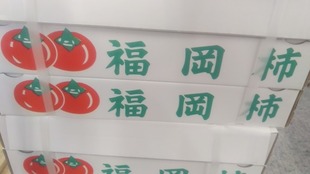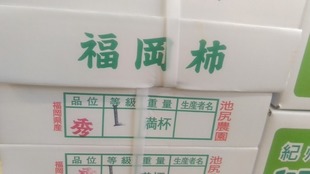【Product name】
Fukuoka persimmon (Fuyu)
【Type】
Diospyros kaki ‘Fuyu’
【Producing area】
Masuuda, Tanushimaru Town, Kurume City, Fukuoka Prefecture (Ikejiri Farm)
【Origin of name】
小倉氏より譲り受けた, 福島氏は, 古典禮記の「四海之内ヲ富有ス」より富有の話を引用して名付けられた.
【Major features】
IKEJIRI Farm belongs to the Fukuoka Chamber of Commerce and Industry. It seems that KYOHO 1.5 ha and FUYU Persimmon 1.5 ha have been cultivated for about 60 years. By cultivating based on the nutritional weekly cultivation theory and supporting the growth of plants with a small amount of fertilizer, we aim to make the harvested fruits safe, secure and nutritious, with no astringency and astringency. There seems to be. In addition, it rarely distributes to the market, and seems to value transactions with mass retailers, mail orders, and restaurants. I hear that it continues to have a track record of exporting to overseas. Based on the origin of the cultivation method of “Tanushimaru”, the land of KYOHO planting, and the nutrition week theory, healthy vines are grown by fertilizing only when necessary. KYOHO, which has been cultivated by hand-salt to make grapes with a deep sweetness that has many layers, is large and has a solid bunch, and is so popular that it has been sold in department stores for a long time. In addition, grape hunting is also carried out, and you can enjoy the exquisite KYOHO, which has no harshness or astringency and has a rich flavor from the fresh fruits in your mouth. In addition, persimmons are also cultivated, and it seems that they sell directly from autumn to winter. It seems that department store buyers also fall in love with it and boast big black balls and bunches. When KYOHO, which has a fresh blue stem, pops in the mouth, the flesh of the fruit bursts, and the mellow sweetness of the juice seems to spread throughout the mouth. The master, who also serves as a lecturer at the Japan KYOHO Association and plays a role in passing on the techniques for making good grapes, is a master of agricultural workers. “Maxvalu Tanushimaru Store(ÆON KYUSHU Co., Ltd.)” in Toyoki, Tanushimaru Town, Kurume City, Fukuoka will be completely closed on February 10, 2022 (Thursday) at 18:00, and “The Big Tanushimaru Store” at 9:00 am on February 18, 2022 (Friday). It seems that it will open next door. On Sunday, February 20, 2022, the “32nd Sasanqua Festival” will be held at Ishigakiyama Kannonji Temple in Ishigaki, Tanushimaru Town, Kurume City, Fukuoka Prefecture. Tendai Sect Ishigakiyama Kannonji is an ancient temple built in the 2nd year of Hakuho, and the “Camellia sasanqua Festival” is held every year on the 3rd Sunday of February, and it seems that this year will be the 32nd time. Harusazanka in Kannonji is a log that is estimated to be 350 years old. It has a trunk circumference of 158 cm and a height of 7 meters, and is a natural monument designated by Kurume City. Every year, the flowers of Camellia sasanqua are half-octuple in the middle and rounded red, and it seems that they will continue to bloom until March. Also, when it is in full bloom, pink petals will be formed under the tree, which will fascinate people. In addition, there is a temple treasure exhibition once a year, and it seems that you can see the temple treasures that are normally closed, such as the hands of Ushioni. The priest who exterminates the priest is the ancestor of Kannonji Chuko, Konko Bonenkaku holy priest. Along with the construction of the various temples, the name of the temple was named “Ennin-in” and 13 temples were selected in analogy to the 13 temples of Garbhadhatu. In addition, the former “Hosou sect” was converted to Tendai sect. Kurume City : In an advanced medical city where the number of top-level doctors(It was triggered by Kurume University(Former Kyushu Vocational School of Medicine : School song : Mr. Hakushu Kitahara), which was founded in 1928.)and medical institutions are concentrated in Japan.State-of-the-art Cancer vaccine research etc. Bio-Industry is also being accumulated. It is famous as the largest agricultural production city in Fukuoka Prefecture with the highest agricultural output in Japan. In the city, Kyushu’s No. 1 large river “Chikugo River(It has been flooded frequently since prehistoric times and caused great damage to the basin, but on the other hand, it created fertile plains and created a rich breadbasket. From the establishment of the Chikugo national government office of nara / heian era to the present, it has developed while receiving blessings as the center of the southern region of Fukuoka prefecture, including the eastern part of Saga prefecture. Edo Period has developed as a castle town of the Arima family, and since modern times it has evolved from the town of Kurume kasuri(cotton cloth called ‘kurume-gasuri’ with splashed patterns)to the town of the rubber industry.)” runs through from the northeast to the west. In the east, there is the Mino mountain range that stands out like a folding screen, and boasts a beautiful natural landscape with lush greenery along with the vast and fertile Chikugo Plain. In 1889, the first municipalism in Japan was implemented with 30 cities nationwide. After that, the city area expanded due to repeated mergers. Merged with Tanushimaru, Kitano, Jyojima and Mizuma Town in February 2005. In April 2008, Kyushu will become the only core city(Designated Mid-Level City)outside the prefectural capital. The city is located inland, with severe summer heat and winter cold, and daily temperature changes are large. The average annual temperature is about 16 degrees Celsius, and the average temperature during the cold season from January to February is 5 to 8 degrees Celsius. I hear that the average temperature in midsummer from July to August is about 27 to 29 degrees Celsius. Throughout the year, it is rich in seasonal changes, with little snow and relatively warm. Produced great ancestors and celebrities who are still famous to this day. It is known as a city with abundant soil, full of individuality and charm, with active activities related to the culture and arts of the citizens. Daizenji Temple Tamataregu: Oniyo-It is one of the three major fire festivals in Japan and is designated as an important intangible folk cultural property of Japan. Kurume Rhododendron L. Rhododendron ferrugineum L. March: A popular event in which over 10,000 walkers from all over Japan participate. Chikugo river fire works festival:Kurume Suitengu Dedication Fireworks Festival ; In 1650, Kurume feudal lord Tadayori Arima(Second generation)-Ko donated the shrine to suitengum. 富有柿 : 1820年(文政3年)に, 美濃国(岐阜(県))大野郡居倉村(瑞穂市居倉)の小倉ノブ氏が,『居倉』「御所柿(奈良県御所市原産)」を, 圃場に植樹されたのが, 始まりと聞いている。Over time, in 1857, his grandson “Chozo” took over his intentions, and in 1884, he entrusted his thoughts to “Saiji Fukushima” in the same district. For the first time, “Goshogaki persimmon” was grafted on the premises of the residential land (* not farmland). In 1898, there was a prefectural show, which was selected (judgment committee). We consulted on the naming of “Fukuju” and “Fuyu” with “Kamekichi Kuze”, the principal of Kawasaki Jinjo Elementary School. It was decided to be a passage of the classic “Li-chi(苛政猛於虎也: A Confucian scholar’s book on gratitude compiled by Taisei from Zhou to Han. All 49 volumes. Respected as one of the Five Classics since the Tang dynasty. Even the precious jade cannot be a good vessel unless it is polished. In the same way, human beings cannot become good members of society who know the way of being human unless they improve themselves by learning. The reason for being a person is polite. The beginning of courtesy is to correct the posture, attitude, and way of walking, then the expression is softened, and finally the wording is careful. Don’t be arrogant or rush with your desires. Only when you fulfill your duties as a child can you fulfill your responsibilities as a parent when you become a parent. Only by fulfilling your duties as a vassal can you fulfill your responsibilities as a monarch when you become a monarch. Only if you have the experience of serving your boss as a subordinate can you master his subordinates when you are in the position of boss. It is a savage human way of life to act as emotions go. The way of life according to gratitude is different from that. A good teacher is like a bell to the students. If you hit it small, it will make a small sound, and if you hit it big, it will make a loud sound.)”, “Fuyu Shikai”, and boasts a splendidly honorable first place. The following year, in 1899, he won the first prize at the 1st Vegetable Fruit Fair hosted by the Prefectural Agricultural Association. In that year, it was selected as a recommended variety of the prefecture by the then governor of Gifu prefecture, “Masaaki Nomura” and below. From “Fuyugaki”, the precocious completely sweet persimmon “Matsumoto Wase Fuyu Persimmon” changed the branch of “Fuyugaki” in the field of Mr. Yutaka Matsumoto in Shigasato Village, Ikaruga District, Kyoto (currently Ayabe City) around 1935. It’s been found. Harvest is expected from mid-October to early November. The Ministry of Agriculture, Forestry and Forestry (Fisheries) certification was named and registered in 1952. “Fuyugaki Persimmon” from Nishiyoshino, which is said to be the finest persimmon. The history of persimmon production in Nishiyoshino Town goes back to the end of the Taisho era. Around this time, planting of “cashed tree crops” in the fields began, and at the same time, the cultivated land was converted to fruit fields, and it seems that clearing was also promoted. Currently, the persimmons produced in Nishiyoshino Town are of the types “Fuyu”, “Hiratanenashi”, and “Wase Tone”, and among them, “Fuyu persimmon”, which has a large production volume, seems to have begun to spread in the early Showa period. From the latter half of the 1955’s to the first half of the 1965’s, the construction of orchards centered on persimmons became popular, and the creation of suitable sites for persimmon production was almost completed. “Fuyu”, which is a representative variety of Sweet persimmon, is carefully selected from those harvested in the season and refrigerated and stored. Immediately after harvesting, each piece is carefully placed in a bag (vacuum packaging) and refrigerated before the freshness is impaired. Advances in refrigeration technology have made it possible to store for a long period of time, and “Fuyu”, which has the same quality as after harvesting, has been popular for a long time.

Fukuoka Prefecture is Japan’s third largest producer of persimmons. Ukiha is particularly active in the Chikugo River basin, centered on Ukiha City, Asakura City, and Kurume City. These areas are facing south, have good sunlight and drainage, and have many gentle slopes, making them very suitable for persimmon cultivation. The reddish Fukuoka persimmon has a firm flesh wrapped in a glossy skin, and when you bite into it, the harmony of crispy texture and surprisingly sweet juice spreads throughout your mouth.

Each ball is carefully individually packaged and shipped in a cosmetic box. Since it is a refrigerated product, it can be stored for a long time compared to persimmons purchased at room temperature. In fact, it’s so soft that it melts. Why don’t you immerse yourself in the afterglow and bite into that feeling?

As I mentioned earlier, Ikejirino Farm is very popular locally as a Kyoho grape farm where you can also hunt house grapes. The underground water of the Minou Mountains is welling up, and the cool breeze blows through it, giving it coolness in midsummer. You can enjoy the real Kyoho while feeling the beautiful nature.



0 件のコメント:
コメントを投稿